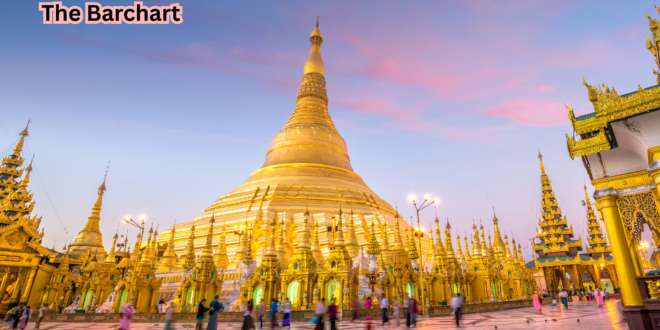Myanmar, often referred to as the “Land of Golden Pagodas,” is a country rich in history, culture, and spiritual significance.
Nestled in Southeast Asia, it is known for its breathtaking landscapes, diverse ethnic groups, and deep-rooted Buddhist traditions.
The name comes from the countless golden pagodas and temples scattered across the country, with iconic sites like the Shwedagon Pagoda in Yangon and the ancient temples of Bagan standing as testaments to its glorious past.
Beyond its architectural marvels, Myanmar is a land of vibrant traditions, warm hospitality, and mystical charm.
The country’s festivals, such as the Thingyan Water Festival and the Tazaungdaing Festival of Lights, add to its cultural vibrancy.
Myanmar’s cuisine, a blend of Indian, Chinese, and Thai influences, offers a unique culinary experience.
Despite its complex political history, Myanmar remains an enchanting destination for travelers seeking untouched beauty and spiritual depth.
From the serene waters of Inle Lake to the bustling streets of Mandalay, every corner of Myanmar tells a story.
Whether you are drawn by its history, culture, or scenic beauty, Myanmar continues to captivate hearts, making it truly the “Enchanting Land of Golden Pagodas.”
Myanmar: A Mysterious and Fascinating Country
Myanmar, formerly known as Burma, is a Southeast Asian country known for its rich history, stunning landscapes, and deeply rooted cultural traditions.
It is a land of golden pagodas, diverse ethnic groups, and breathtaking natural beauty.
From the bustling streets of Yangon to the serene temples of Bagan, Myanmar captivates visitors with its mystical charm.
Despite its complex political past, the country continues to be a place of intrigue, attracting travelers and historians alike.
The blend of ancient traditions with modern aspirations makes Myanmar a unique destination that holds an air of mystery and fascination.
The History of Myanmar: A Look into the Past
Myanmar’s history dates back thousands of years, with early civilizations emerging around the 9th century.
The Pagan Kingdom, which thrived from the 11th to 13th centuries, laid the foundation of Burmese culture and Buddhism in the region.
Later, Myanmar experienced colonial rule under the British Empire from 1824 until 1948, when it gained independence.
The country then underwent political turmoil, including military rule and democratic transitions.
Myanmar’s history is marked by resilience and cultural evolution, making it an interesting subject for those who seek to understand Southeast Asia’s past and present.
From Yangon to Mandalay: A Journey Through Myanmar
A journey through Myanmar is incomplete without exploring its major cities.
Yangon, the former capital, is home to the famous Shwedagon Pagoda, a golden structure that dominates the skyline.
Mandalay, the last royal capital, is rich in history and houses ancient monasteries and the renowned U Bein Bridge.
Bagan, an ancient city with thousands of temples, is another must-visit destination.
Each city offers a unique glimpse into Myanmar’s past and present, making a journey through the country an unforgettable experience.
Myanmar’s Culture and Traditions
Myanmar’s culture is deeply rooted in Buddhist traditions, with more than 80% of the population practicing Theravāda Buddhism.
The people of Myanmar are known for their warm hospitality and traditional attire, such as the longyi, a sarong-like garment worn by both men and women.
The country’s folklore, music, and dance are influenced by its diverse ethnic groups, each contributing to the rich cultural tapestry.
Respect for elders and religious customs plays a significant role in daily life, preserving Myanmar’s heritage and traditions for future generations.
Buddhist Monasteries and the Spiritual Essence of Myanmar
Buddhist monasteries are an integral part of Myanmar’s landscape and spiritual life.
The Shwedagon Pagoda in Yangon, the Mahamuni Buddha Temple in Mandalay, and the countless stupas of Bagan showcase the country’s devotion to Buddhism.
Monks and nuns play a crucial role in society, with many young boys joining monastic life for a period of time as part of their spiritual journey.
These monasteries serve as centers of learning, meditation, and community support, reinforcing Myanmar’s identity as a deeply spiritual nation.
Delicious Myanmar Cuisine and Local Dishes
Myanmar’s cuisine is a delightful fusion of flavors influenced by neighboring countries such as India, China, and Thailand.
Traditional dishes include Mohinga, a fish-based noodle soup considered the national dish, and Laphet Thoke, a unique tea leaf salad.
Other popular foods include Shan noodles, curries served with a variety of side dishes, and samosas.
Street food is also an essential part of Burmese culinary culture, offering a wide array of tasty treats that reflect the country’s diverse heritage.
Tourism Guide: Famous Attractions in Myanmar
Myanmar is home to many breathtaking attractions.
The ancient city of Bagan, with its thousands of temples, is a UNESCO World Heritage Site and a must-visit destination.
Inle Lake, known for its floating villages and leg-rowing fishermen, offers a unique cultural experience.
The Golden Rock Pagoda, precariously balanced on a cliff, is a significant pilgrimage site.
Additionally, the pristine beaches of Ngapali provide a relaxing retreat for visitors.
Whether exploring historical sites or enjoying nature’s beauty, Myanmar offers something for every traveler.
Myanmar’s Economy and Business Opportunities
Myanmar’s economy is largely based on agriculture, natural resources, and trade.
Rice, teak, jade, and precious stones are major exports, contributing to the country’s revenue.
With recent economic reforms, foreign investments in tourism, manufacturing, and infrastructure have increased.
However, challenges such as political instability and infrastructure limitations remain.
Despite these hurdles, Myanmar’s strategic location between India, China, and Southeast Asia presents significant business opportunities for growth and development.
Myanmar’s Political Landscape: Past and Present
Myanmar’s political landscape has seen significant changes over the years.
After gaining independence in 1948, the country faced decades of military rule, which impacted its development.
The transition to democracy in recent years has been met with both progress and challenges.
Issues such as ethnic conflicts, human rights concerns, and governance reforms continue to shape Myanmar’s political future.
Understanding the country’s political history is essential to grasp the complexities of its current situation and future prospects.
Famous Festivals and Celebrations of Myanmar
Myanmar hosts numerous vibrant festivals throughout the year, reflecting its rich cultural and religious heritage.
The Thingyan Water Festival, similar to Thailand’s Songkran, marks the Burmese New Year and is celebrated with water fights and festivities.
The Tazaungdaing Festival of Lights illuminates the country with candlelit celebrations.
The Pagoda Festivals, held at various temples, draw large crowds for prayers and community gatherings.
These festivals provide an immersive experience into Myanmar’s traditions, allowing visitors to witness the country’s lively spirit.
Conclusion
Myanmar is a land of mystique, history, and cultural richness.
From its golden pagodas and ancient cities to its delicious cuisine and warm people, Myanmar offers an unforgettable experience.
Despite political and economic challenges, the country remains a fascinating destination that continues to evolve.
Whether exploring its spiritual essence, engaging with local traditions, or discovering its breathtaking landscapes, Myanmar captivates all who visit.
As Myanmar opens its doors to the world, it remains an enchanting land with endless stories to tell.




